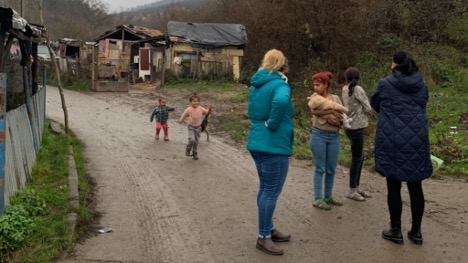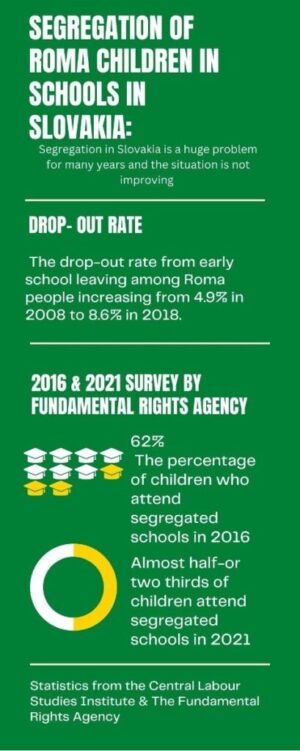Segregation of Roma Children in Schools: A Challenge for Slovakia
EUROPE, 13 Mar 2023
Katarina Spisak | Euroviews Impact - TRANSCEND Media Service
According to a survey published in 2021 by the Fundamental Rights Agency, between half and two-thirds of Roma children attend segregated schools in Slovakia. It is the largest number among 10 countries surveyed.

The local Roma settlement in a village called Zemplinska Teplica in the east part of Slovakia and the local Roma children living there with the two social workers in blue jackets talking to them. (Photo: Katarina Spisakova)
Another survey surrounding segregation in Slovakia has been done by the Fundamental Rights Agency in 2016 which showed that 62% of Roma children attend segregated classrooms and schools like in any other European country.

Infographics, the statistics are from the Central Labour Studies Institute & The Fundamental Rights Agency.
Slovakia is in the European Union and according to the source for the Slovak newspaper- Dennik SME, the European Commission has been in contact with Slovakia since 2015 to eliminate the segregation of Roma children. However, statistically, no progress has been achieved in solving this until today.
In 2015, The European Commission threatened to sue Slovakia because of the lack of information provided to the Commission on how the country wants to solve the issue of segregation in schools. The Slovak government argued that the main reason why Roma children are segregated and sent to special schools is because of incest, Dennik SME reported. This back then sparked national outrage mainly between non-profit organizations such as Amnesty International Slovakia.
In October 2019, the European Commission has said that the situation with segregation in Slovakia has not improved and again asked the country to take measures to eliminate segregation in two months and if not the European Commission will take legal action against the country.
There are still many segregated schools in Slovakia especially in the central and eastern part of the country.
“The aim of the Ministry of Education, Science, Research and Sport of the Slovak Republic is to ensure accessible and quality education – EDUCATION FOR ALL CHILDREN. It has therefore adopted the Strategy for an Inclusive Approach to Education and Training (approved by the Government of the Slovak Republic on 8 December 2021), in which it commits itself to fulfilling this goal. It rejects segregation of any kind”, Silvia Durkova from the Slovak Ministry of Education, told me.
Many years of no systematic solutions to desegregating schools in Slovakia, it has become normal to the majority people in the country and to the Roma minority too.

The non-governmental organization – Dive maky, advertising their new merch. (Photo: Dive maky website, divemaky.sk)
“Of course, we perceive the segregation of Roma children in the Slovak school system as very problematic. Moreover, it is a problem that has been known for a long time and yet remains without systematic solutions, and so more and more children are falling into the cycle of special schools (thanks to special diagnoses) or entering purely Roma schools. All this has a negative impact not only on their education as such, but also on as if they were something strange and could not be in the same class or even school together with the non-Roma. This creates a distorted impression of Roma children and people for the majority, and at the same time creates a false self-image in the Roma children themselves”, Maria Siroka from the non-governmental organization – Dive maky, said.
Poverty remains the main issue. Many Roma children in Slovakia often come from very poor living conditions and live in extreme poverty. They live in settlements with one source of water, no heating, no electricity and no food to eat. Based on the study conducted by the Central European Labour Studies Institute in 2020, it has been estimated that the Roma population in Slovakia face 87% higher risk of poverty compared to 13% of the general public. Therefore, the analysts in Slovakia say that education has nothing to do with ethnicity but rather with the poverty. Ultimately, the poverty makes it very challenging for Roma children to succeed and continue in their studies.
There are many non-governmental organizations helping talented Roma children with scholarships such as Dive maky, “As an organization, we are primarily engaged in providing scholarships for gifted Roma children from socially disadvantaged backgrounds. In this way we try to help our scholarship holders in the development of their education and talent”, Ms Siroka from Dive maky said.
In a village Zemplinska Teplica located in the Eastern part of Slovakia, the segregation of Roma children is very much still present with no possible future changes. In a last year or so the local primary school became Roma-only with just a few non-Roma children.
The local primary school – Zakladna Skola Zemplinska Teplica, has seen a significant loss of non-Roma children from the school. One of the main reasons of parents taking their children away from the school is the bad behaviour of Roma children in classrooms. “Many non-Roman children have left the school because of the behaviour of Roma children and those children felt they could not concentrate in class”, Silvia Buzinkaiova – the social educator at the local school, told me.

Social Educator – Silvia Buzinkaiova at the local primary school in Zemplinska Teplica, Slovakia. (Photo: Katarina Spisakova)

Previous mayor of Zemplinska Teplica village in Slovakia – Jozefina Uhalova. (Photo: Katarina Spisakova)
Another problem a village is facing with Roma children is the hygiene. Jozefina Uhalova who in the time of doing this report has still been the mayor of the village told me, “When they come to school in the morning, many Roma children have problems with hygiene. Some children have parasites or are sick which could endanger other children”. When asked about the issue with segregation in the local primary school, Mrs. Uhalova told me, “Our school had each year around 300 children and some Roma children were classified into special classes based on the examination of psychologist. It is also believed that these reports from psychologists were manipulated however in our case they were not. In my opinion the children who are segregated are mostly the ones who are not taken care of by their parents or are dirty”.
Segregation still remain a huge issue in Slovakia. One of the main factors contributing to the issue are prejudices, stereotypes and hoaxes between the general public in the country. These factors are getting worse and worse every year and the state is not helping them to improve. “Segregation is also caused by various logistical reasons such as access to school (accessibility itself can be caused by spatial segregation), but of course also by reasons stemming from misunderstanding and prejudice. These problems have been growing deeper and deeper over the years, until they are slowly becoming gaps that individual people/children cannot overcome on their own,” Dive Maky – NGO, told me.
However, the mayor of Zemplinska Teplica village thinks otherwise. She believes that the factors contributing to the problem of segregation in the country are not very much caused by prejudices or stereotypes but rather the family backgrounds of these children. Many Roma children come from families where alcohol and vulgarisms are very much present on daily basis. Therefore non-Roma children feel uncomfortable being with those Roma children in class and then forces the school to be segregated.
There are many solutions created by NGO’s, teachers, politicians and general public to improve the situation with segregation in Slovakia. However, over the years many have failed or have not been implemented properly.
According to Amnesty International Slovakia official website in 2020, they have created a list of proposals to the Slovak government on how to solve the issue with segregation. They suggest that the government ensures that all children in special schools are reassessed and transitioned to the main schools with appropriate support and ensures successful implementation of all successful projects aimed at children from socially disadvantaged backgrounds with the state funding.
Another proposals to the Slovak government on desegregation of Roma children is described in a document written by eduRoma organization – Roma Education Project. Their proposals are very similar to the ones from Amnesty International Slovakia such as the government must implement inclusive education as the ultimate goal of education, that benefits all not just a few, the need of school integration as an inclusion of separated pupils into diverse learning community and the full recognition of desegregation into the real World in order to remove segregation of specific pupils.
After all, many people in the country say that it is the government that should do the most work in order to change the situation with segregation.
“Only with the help of state measures is it possible for segregation in schools to disappear in the future. But this would require a great deal of active effort, a continuous approach and, last but not least, the perception of the issue as a priority, ” Ms. Siroka from Dive Maky, told me.
The video is about the segregation of Roma children in the Slovak education system and the segregated primary school in Zemplinska Teplica, Slovakia.
By Katarina Spisako:
The audio is about the general issue of segregation of Roma children in Slovak schools. By Katarina Spisako:
__________________________________________
Katarina Spisakova is a journalism student at the London College of Communication. Originally from Slovakia, she moved to the UK to study the IB diploma programme in 2018 and finished her studies in 2021. She has worked as a broadcaster at TV Nasa in Slovakia and recently joined The European Correspondent to cover Slovakia for an European audience. She intends to be an international news correspondent for TV or radio.
Tags: Children, Europe, Gypsies, Inequality, Racism, Romani People, Segregation
DISCLAIMER: The statements, views and opinions expressed in pieces republished here are solely those of the authors and do not necessarily represent those of TMS. In accordance with title 17 U.S.C. section 107, this material is distributed without profit to those who have expressed a prior interest in receiving the included information for research and educational purposes. TMS has no affiliation whatsoever with the originator of this article nor is TMS endorsed or sponsored by the originator. “GO TO ORIGINAL” links are provided as a convenience to our readers and allow for verification of authenticity. However, as originating pages are often updated by their originating host sites, the versions posted may not match the versions our readers view when clicking the “GO TO ORIGINAL” links. This site contains copyrighted material the use of which has not always been specifically authorized by the copyright owner. We are making such material available in our efforts to advance understanding of environmental, political, human rights, economic, democracy, scientific, and social justice issues, etc. We believe this constitutes a ‘fair use’ of any such copyrighted material as provided for in section 107 of the US Copyright Law. In accordance with Title 17 U.S.C. Section 107, the material on this site is distributed without profit to those who have expressed a prior interest in receiving the included information for research and educational purposes. For more information go to: http://www.law.cornell.edu/uscode/17/107.shtml. If you wish to use copyrighted material from this site for purposes of your own that go beyond ‘fair use’, you must obtain permission from the copyright owner.